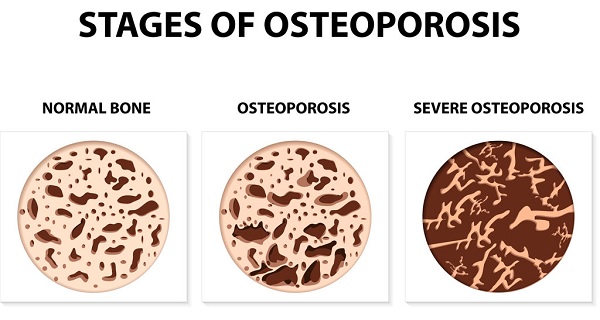Osteoporosis Symptoms & Treatment Options
Osteoporosis occurs when the bones that make up your skeletal system, spine, and joints become porous and frail. While this disease often affects older women, any adult—and even some children—can experience this degenerative condition.
Remember: Your bones are not a static part of your body. Rather, your skeleton undergoes constant regeneration, as newer, healthier cells replace old, worn-out cells. Bone remodeling introduces new cells through a process called formation, whereas a cycle called resorption removes old cells. This process also involves deposits of elements such as calcium and other minerals to the bone and is an active recycling process. However, osteoporosis disrupts this rhythm. Old bone cells still die, but no new ones replace them, and loss of calcium and mineralizations occurs.
This imbalance can leave literal holes in your bones. In fact, the Latin root words of osteoporosis translate to “porous bone.” Sometimes likened to a kitchen sponge, an osteoporotic bone will begin to develop small cavities, channels, and holes. Caused by any number of factors, osteoporosis can lead to a host of painful, limiting, and sometimes, debilitating symptoms.
Symptoms of Osteoporosis
Doctors and patients may struggle to recognize the early clues associated with osteoporosis. Often, no obvious symptoms will emerge during the initial phases of the condition. In fact, one may not realize that he or she has osteoporosis until that first fracture occurs. However, if you know what to look out for, you can distinguish some early warning signs.
We specializes in the treatment of age-related degeneration, such as osteoarthritis and osteoporosis. Embracing a conservative approach, he will explore all avenues to deliver relief and spinal stability from osteoporosis. Call Dr. Martin and his team today to set up your first appointment!
Risk Factors for Developing Osteoporosis
Although Osteoporosis can affect anyone, certain factors make some individuals more susceptible than others.
Age: Our bones naturally grow thinner over time, even without the thinning effects of osteoporosis. This natural degeneration can make both women and men more susceptible to osteoporosis.
Menopause: Furthermore, fluctuations in hormones due to menopause can cause changes in bone development and regeneration. This makes older women especially vulnerable to osteoporosis.
Genetics: Likewise, a family history of osteoporosis can increase your likelihood of developing this condition in later life.
Small Frame: In addition, osteoporosis is more prevalent in those with a small or thin body frame.
Vitamin Deficiencies: Low levels of Calcium and Vitamin D have been shown to correlate with osteoporosis.
Smoking: Smoking causes a lower bone density, which be especially harmful to women post-menopause. Smoking does not discriminate, however. Men who smoke also tend to have lower bone densities.
Excessive Alcohol Consumption: Alcohol increases one’s risk for osteoporosis. Drinking slows the absorption of necessary vitamins and inhibits the body’s development of bone-restoring osteoblasts. Furthermore, alcohol increases the level of cortisol in the body. And, the hormone cortisol has been shown to inhibit bone formation and promote bone degeneration.
Lack of Exercise: Living a sedentary life, void of meaningful exercise, increases your chances for developing osteoporosis. However, engaging in weight-bearing and strength-building exercise can prevent osteoporosis. (Exercise also prevents a host of other diseases that result from aging or an unhealthy lifestyle.)
Likewise, a number of medical conditions can promote the development of osteoporosis, including diabetes, lupus, breast cancer, Parkinson’s disease, and even depression. Not only this, but certain doctor-prescribed medications can accelerate the progression of osteoporosis. The good news, however? You can choose from a variety of successful and minimally invasive treatment options.
Keep A Watchful Eye Out For The Following Indicators Of Weakened Bones:
- Weaker Grip Strength: One may begin to notice a loss of the ability to grip, hold, and lift objects. This weakness can also affect one’s ability to grab handrails or counters while avoiding falls.
- Thinning of the Fingernails: The fingernails may become frail, break, or flake apart easily.
- Loss of Height: Loss of space between the vertebrae can lead to diminishing overall height.
- Fractures: Bone fractures are common, especially in the hands, feet, and the hips.
- Kyphosis: Loss of vertebral space can lead to kyphosis, or a hunched-over thoracic spine
- Back Pain: Spinal compression fractures and pinched spinal nerves may cause back pain.
More about Dr. Matin
Osteoporosis Symptoms & Treatment Options
Osteoporosis pain can be treated by Dr. Martin, give us a call to schedule an appointment.
We will provide different options of treatment.
Lifestyle Changes and medication
Changing one’s lifestyle can make all the difference. Eating healthy, quitting smoking, cutting down on alcohol consumption, and adding in some exercise can help to avoid osteoporosis. In particular, physical therapists and nutritionists can aid with lifestyle goals. When osteoporosis is advanced your doctor will prescribe medication that targets receptors that facilitate mineralization of your bones to avoid progression and fractures.
Kyphoplasty
A Kyphoplasty is a minimally invasive surgical option for repairing fractured vertebrae. A balloon is inflated to restore vertebral height in the shattered vertebra. Then, a hardening cement is injected into the restored space to maintain vertebral stability.
Vertebroplasty
Like a Kyphoplasty, a minimally invasive Vertebroplasty helps to restore stability to the fractured vertebrae. Without using a balloon, your surgeon will inject a hardening cement into the fracture. After a short drying time, the vertebra is stabilized.






